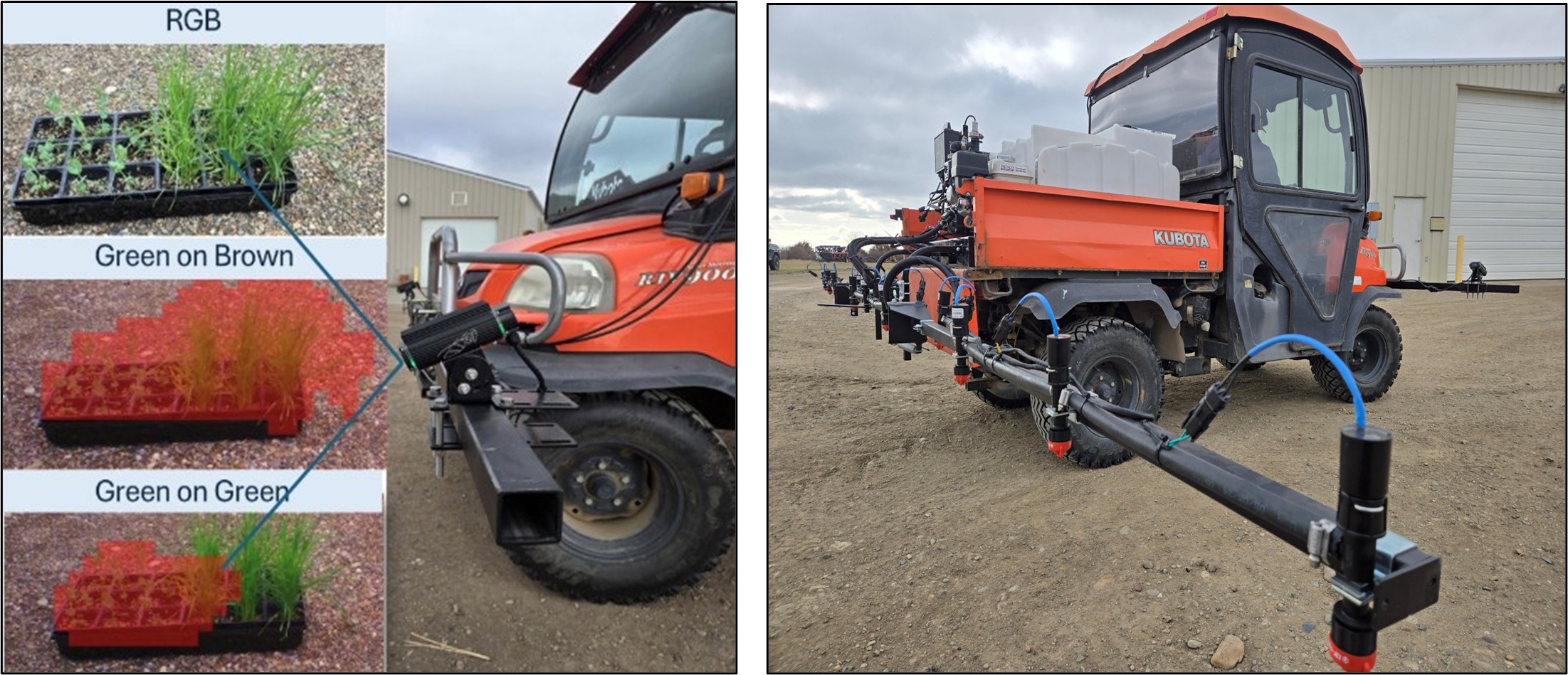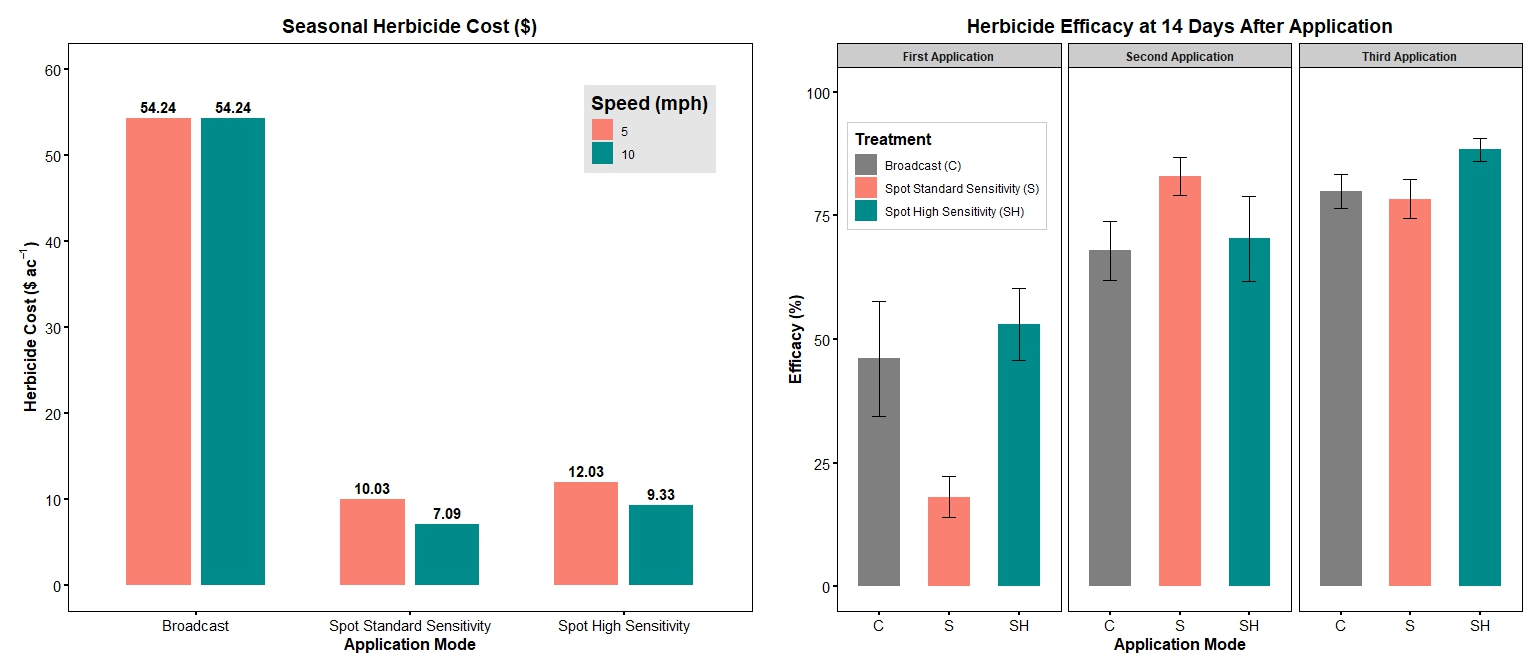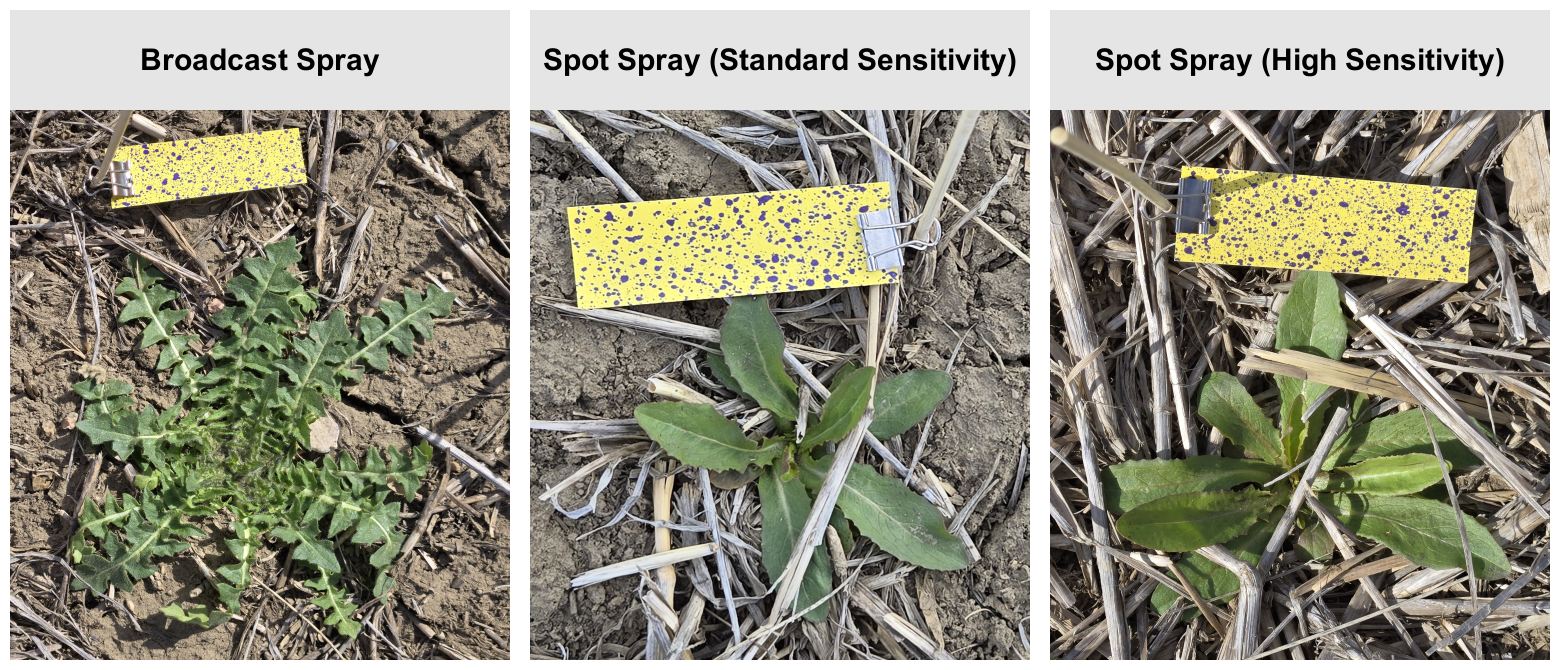Precision Ag Update - October 2025
Targeted Herbicide Applications in Montana Fallow Fields: Improving Efficiency and Reducing Costs
Written by: Madhusudhan Adhikari, Sudhir Payare, Kelsey Larson and Ricardo Pinto, October 2025
Why Adopt Targeted Herbicide Applications?
Problematic weeds such as kochia, Russian thistle, green foxtail, and wild oat are increasingly threatening dryland cereal systems in Montana (Jha et al., 2016; Kumar et al., 2017). Many farms rely on blanket spraying during fallow, but this approach often results in unnecessary herbicide use. Excess application increases input costs and accelerates the development of herbicide-resistant weeds, especially if herbicide rotation is not carefully followed (Menalled & Dyer, 2011). With tight profit margins and no new herbicide modes of action expected, more efficient weed-control options are essential.
One promising approach is targeted herbicide application, where spray is applied only where weeds are present. Chlorophyll fluorescent-based systems such as Weed IT and WeedSeeker have been shown to reduce herbicide use by 53–86% in Washington and Nebraska (Genna et al., 2021) and 23–55% in Montana trials, saving $2.36 to $12.45 per acre while maintaining effective control (Sharma et al., 2023). By minimizing chemical use while controlling weeds, precision spraying stretches herbicide dollars and supports economic and environmental sustainability.
What We Tested
Camera-based systems represent the next generation of “see-and-spray” smart spraying technology, enabling real-time weed detection for targeted herbicide application. These systems can operate in:
- Green-on-Brown: Targeting weeds on bare soil
- Green-on-Green: Distinguishing weeds growing within crop canopies
In our trials, we used the SmartStriker X system, which combines RGB and hyperspectral cameras (Figure 1). While RGB provides standard color information, hyperspectral imagery captures hundreds of narrow spectral bands, detecting subtle differences between crops and weeds that the human eye or conventional cameras cannot see. For this study, the system operated in Green-on-Brown mode, optimized for weed detection in fallow fields.

Figure 1. Real-time weed detection under different modes by Carbon Bee SmartStriker X (left) and sprayer system mounted on Kubota-UTV (right) during the 2025 study.
We focused on two key questions:
- Profitability: What is the return on investment (ROI), and how much can be saved by reducing herbicide use?
- Efficiency: How does the system perform compared to standard broadcast spraying, and does operating speed and crop residue affect accuracy and effectiveness?
Three application modes were compared:
- Conventional broadcast spraying
- Targeted spraying at standard sensitivity (detect weeds as small as 2” × 2”)
- Targeted spraying at high sensitivity (detect weeds as small as 0.3” × 0.3”)
We tested applications at two travel speeds, 5 mph and 10 mph, to assess the effect of speed on weed detection and spray performance. Herbicide was applied on April 24, May 22, and June 24, 2025. Key performance metrics calculated included weed-detected areas (acres), relative herbicide savings (%), spray efficacy (weed coverage reduction at 14 days after herbicide application), and seasonal cost savings ($ per acre). Herbicide spray coverage (%) was quantified using water-sensitive paper placed close to small-sized weeds (0.3” × 0.3”) during the first herbicide application.
Key Findings
- Herbicide savings: Spot spray mode achieved 71–92% savings compared to conventional broadcast. Even with new weed flushes in mid-summer, savings remained substantial (79–90% in the second application and 71–85% in the third).
- Weed control efficacy: Spot spraying maintained similar control to broadcast, with efficacy ranging from 18–46% after the first application, 68–83% after the second, and 78–88% after the third. Travel speed (5 vs. 10 mph) had no impact on efficacy.
- Spray modes: No significant differences were observed between high and standard sensitivity settings.
- Broadcast vs. spot spray: Weeds only covered a small share of the ground in the broadcast treatment areas, suggesting that a targeted approach could have achieved herbicide savings similar to the savings observed in the spot spray areas.
- Seasonal cost savings: Net savings ranged from $7–$7.5, $15–$17, and $19–$23 per acre for the first, second, and third applications. Total seasonal savings were $43.5/ac under high sensitivity and $45.5/ac under standard sensitivity.
- Spray Coverage: Spot spray achieved comparable weed surface coverage to broadcast spraying, with values ranging from 18.9% to 23% (Figure 3). This demonstrates that spot spray can effectively target and cover the full weed surface area at a level similar to conventional broadcast applications.
Best practices: To maximize efficacy, producers should pay attention to weather conditions, calibration, and sprayer settings such as boom height, nozzle angle, and overlap to ensure detected weeds receive the correct herbicide dose.

Figure 2. Seasonal herbicide cost ($ per acre, left) and herbicide efficacy (%, right) for conventional broadcast and spot spray modes during the 2025 study. Cost estimates are shown across different application speeds (mph), while efficacy was measured 14 days after each herbicide application.

Figure 3. Herbicide deposition on water-sensitive papers (1" × 3") under different modes of application during the first herbicide application. The blue dots visible on the yellow background of the water-sensitive paper represent individual herbicide droplets deposited on the surface during spraying. The droplets deposition patterns in these papers confirmed that both conventional broadcast and spot spray modes effectively spray herbicide directly onto and around the weed surfaces.
What Does This Mean for Your Operation?
Producers in Montana’s dryland systems can achieve substantial economic and agronomic benefits by adopting spot spray technologies:
- Reduced herbicide uses without sacrificing control
- Seasonal herbicide savings of approximately $43.5–$45.5 per acre during summer fallow
- For Montana’s average farm size of 2,412 acres (USDA NASS, 2024), this could reduce costs by $104,922–$109,746 per farm per season
Widespread adoption could also benefit the state’s agricultural economy. To help producers estimate potential savings, the MSU Extension – NARC Precision Agriculture Lab developed a Smart Sprayer ROI Calculator, which allows comparison of conventional vs. smart spraying costs based on acreage, herbicide rates, and settings.
Targeted spray technology also supports long-term sustainability by reducing overuse of herbicides and improving herbicide resistance management, by enabling the use of different herbicide modes of action.
Considerations Before Adopting
Before adopting spot spray technology, producers should consider:
- Cost and equipment compatibility: Check initial purchase cost and whether a subscription is required. Our Smart Spray ROI calculator can help you determine whether the savings are likely to compensate for these added costs.
- Field conditions: Start with a small field segment to learn system settings and optimize performance. Targeted spraying will achieve its highest ROI in fields with low weed pressure.
- System capabilities: Not all smart sprayers detect weeds in standing crops; choose a system that supports your crop types and target weeds. Currently, Carbon Bee SmartStriker X supports fallow weed detection and broadleaf identification in wheat, barley, and about 20 crops supported by the system.
Summary
- Spot spray modes reduced herbicide use by an average of 84%, ranging from 71–92% over the study period.
- Targeted spraying was equally effective in controlling weeds as conventional broadcast.
- Estimated savings of $43.5–$45.5 per acre during summer fallow weed management.
Acknowledgements
We are grateful to the Montana Agricultural Experiment Station and the Montana Wheat and Barley Committee for funding this research. Their support made it possible to evaluate and demonstrate the benefits of camera-based system targeted herbicide application in Montana fallow fields.
References
USDA NASS. (2024). 2024 State Agriculture Overview—Montana [Survey].
Get Connected & Learn More

Ricardo Pinto
Precision Agriculture Research/Extension

Kelsey Larson
Agricultural Economics/MSU Extension Specialist
